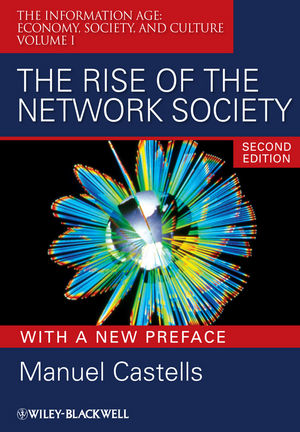The Rise of the Network Society, 2nd Edition, with a New PrefaceISBN: 978-1-4051-9686-4
Paperback
656 pages
August 2009, Wiley-Blackwell
 |
||||||
List of Tables xiv
Acknowledgments 2000 xvii
Acknowledgments 1996 xlv
Preface to the 2010 Edition of The Rise of the Network Society lv
Prologue: the Net and the Self 1
Technology, Society, and Historical Change 5
Informationalism, Industrialism, Capitalism, Statism: Modes of Development and Modes of Production 13
Informationalism and capitalist perestroika 18
The Self in the Informational Society 21
A Word on Method 25
1 The Information Technology Revolution 28
Which Revolution? 28
Lessons from the Industrial Revolution 33
The Historical Sequence of the Information Technology Revolution 38
Micro-engineering macro-changes: electronics and information 39
The creation of the Internet 45
The 1970s' technological divide 53
Technologies of life 54
Social context and the dynamics of technological change 59
Models, Actors, and Sites of the Information Technology Revolution 61
The Information Technology Paradigm 69
2 The New Economy: Informationalism, Globalization, Networking 77
Productivity, Competitiveness, and the Informational Economy 78
The productivity enigma 78
Is knowledge-based productivity specific to the informational economy? 80
Informationalism and capitalism, productivity and profitability 94
The historical specificity of informationalism 99
The Global Economy: Structure, Dynamics, and Genesis 101
Global financial markets 102
Globalization of markets for goods and services: growth and transformation of international trade 106
Globalization versus regionalization 110
The internationalization of production: multinational corporations and international production networks 116
Informational production and selective globalization of science and technology 124
Global labor? 130
The geometry of the global economy: segments and networks 132
The political economy of globalization: capitalist restructuring, information technology, and state policies 135
The New Economy 147
3 The Network Enterprise: the Culture, Institutions, and Organizations of the Informational Economy 163
Organizational Trajectories in the Restructuring of Capitalism and in the Transition from Industrialism to Informationalism 164
Network technologies and pervasive computing 51
Small business and the crisis of the large corporation: myth and reality 167
"Toyotism": management–worker cooperation, multifunctional labor, total quality control, and reduction of uncertainty 169
Inter-firm networking 172
Corporate strategic alliances 174
The horizontal corporation and global business networks 176
The crisis of the vertical corporation model and the rise of business networks 178
Networking the networks: the Cisco model 180
Information Technology and the Network Enterprise 184
Culture, Institutions, and Economic Organization: East Asian Business Networks 188
A typology of East Asian business networks 189
Japan 190
Korea 191
China 193
Culture, organizations, and institutions: Asian business networks and the developmental state 195
Multinational Enterprises, Transnational Corporations, and International Networks 206
The Spirit of Informationalism 210
4 The Transformation of Work and Employment: Networkers, Jobless, and Flex-timers 216
The Historical Evolution of Employment and Occupational Structure in Advanced Capitalist Countries: the G-7, 1920–2005 217
Post-industrialism, the service economy, and the informational society 218
The transformation of employment structure, 1920–1970 and 1970–1990 224
The new occupational structure 232
The maturing of the informational society: employment projections into the twenty-first century 237
Summing up: the evolution of employment structure and its implications for a comparative analysis of the informational society 243
From mass production to flexible production 166
The Work Process in the Informational Paradigm 255
The Effects of Information Technology on Employment: Toward a Jobless Society? 267
Work and the Informational Divide: Flex-timers 281
Information Technology and the Restructuring of Capital–Labor Relations: Social Dualism or Fragmented Societies? 296
Appendix A: Statistical Tables for Chapter 4 303
Appendix B: Methodological Note and Statistical References 338
5 The Culture of Real Virtuality: the Integration of Electronic Communication, the End of the Mass Audience, and the Rise of Interactive Networks 355
From the Gutenberg Galaxy to the McLuhan Galaxy: the Rise of Mass Media Culture 358
The New Media and the Diversification of Mass Audience 365
Computer-mediated Communication, Institutional Control, Social Networks, and Virtual Communities 371
The Minitel story: l'état et l'amour 372
The Internet constellation 375
The interactive society 385
The Grand Fusion: Multimedia as Symbolic Environment 394
The Culture of Real Virtuality 403
6 The Space of Flows 407
Advanced Services, Information Flows, and the Global City 409
The New Industrial Space 417
Everyday Life in the Electronic Cottage: the End of Cities? 424
The Transformation of Urban Form: the Informational City 429
America’s last suburban frontier 429
The fading charm of European cities 431
Third millennium urbanization: mega-cities 434
The Social Theory of Space and the Theory of the Space of Flows 440
The Architecture of the End of History 448
Space of Flows and Space of Places 453
Is There a Global Labor Force? 247
7 The Edge of Forever: Timeless Time 460
Time, History, and Society 461
Time as the Source of Value: the Global Casino 465
Flex-time and the Network Enterprise 467
The Shrinking and Twisting of Life Working Time 468
The Blurring of the Life-cycle: Toward Social Arrhythmia? 475
Death Denied 481
Instant Wars 484
Virtual Time 491
Time, Space, and Society: the Edge of Forever 494
Conclusion: the Network Society 500
Summary of the Contents of Volumes II and III 510
Bibliography 512
Index 566



